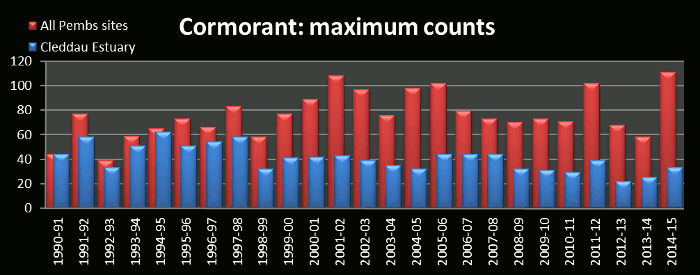Breeding resident
Mathew (1894) noted Cormorant colonies at Ramsey, Skomer, Lydstep Head and Pointz Castle, Lockley et al. (1949) adding St Margaret's Island, St Bride's Stacks, Pwll Deri and Newport Head.
In 1969, during Operation Seafarer, 378-388 pairs were found breeding, while the Seabird Register of 1985-1987 found 362 pairs, so the population has remained fairly stable despite variation in the sizes of individual colonies. Cormorants are seen throughout the year with the colonies usually occupied from February to September, ranging from single pairs breeding on cliff sites to the largest colony in Wales at St Margaret's Island, which held 322 nests in 1973, but 230 pairs in most years since (see Table 2). Mathew (1894) recorded nesting in trees at Slebech.
Ringing at St Margaret's Island has shown that some birds remain in Pembrokeshire waters throughout the year but others, mainly immatures, move up the Bristol Channel during the winter, or along the length of the English Channel and into the Bay of Biscay as far as the Iberian peninsula. Some pass inland to the Thames Valley, a few reach Ireland and North Wales and one has been recovered in Holland. Additionally, each autumn strings of up to 20 birds are seen passing down through the southern Irish Sea and St George's Channel from the north, and Irish‑bred birds have been noted at St Margaret's Island.
Cormorants fish extensively in the shallow bays around the Pembrokeshire coast, penetrate all the estuaries and rivers and regularly frequent the larger inland waters such as Llysyfran reservoir, besides visiting quite small pools on an opportunistic basis. Winter roosts of up to 47 birds include several breeding sites but they also roost elsewhere, notably in trees at Llysyfran reservoir, Slebech and Femhill.
 Fieldwork 1984-88 (based on 478 tetrads)
Fieldwork 1984-88 (based on 478 tetrads)
Red = breeding confirmed = 13
Orange = breeding probable = 1
Total tetrads in which registered = 14 (2.9%)
Donovan J.W. & Rees G.H (1994), Birds of Pembrokeshire
 Tuesday, January 26, 2016 at 11:55AM
Tuesday, January 26, 2016 at 11:55AM 
 Pembrokeshire Avifauna committee | Comments Off |
Pembrokeshire Avifauna committee | Comments Off | 





